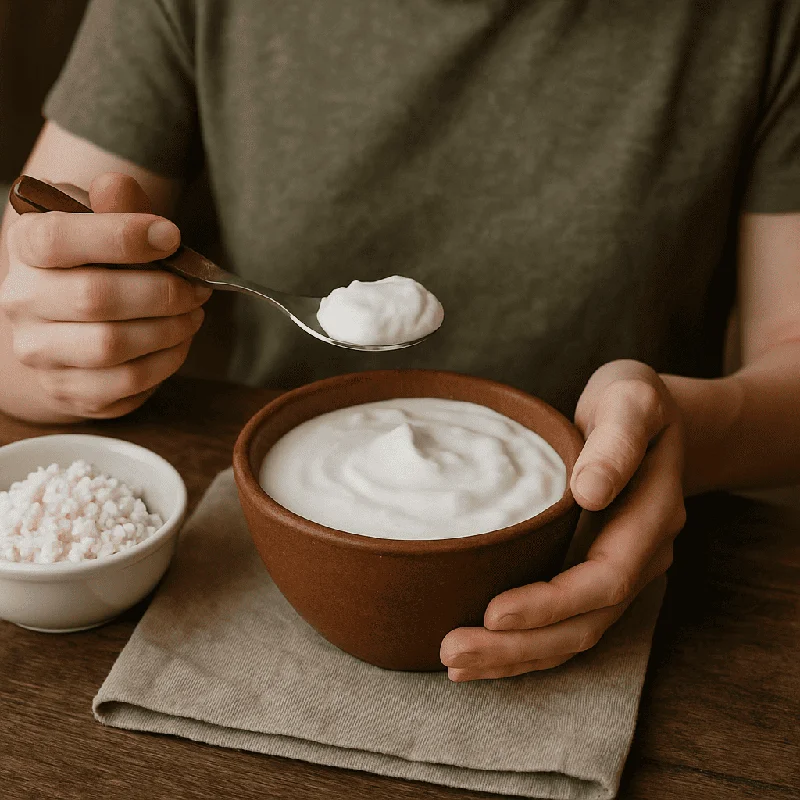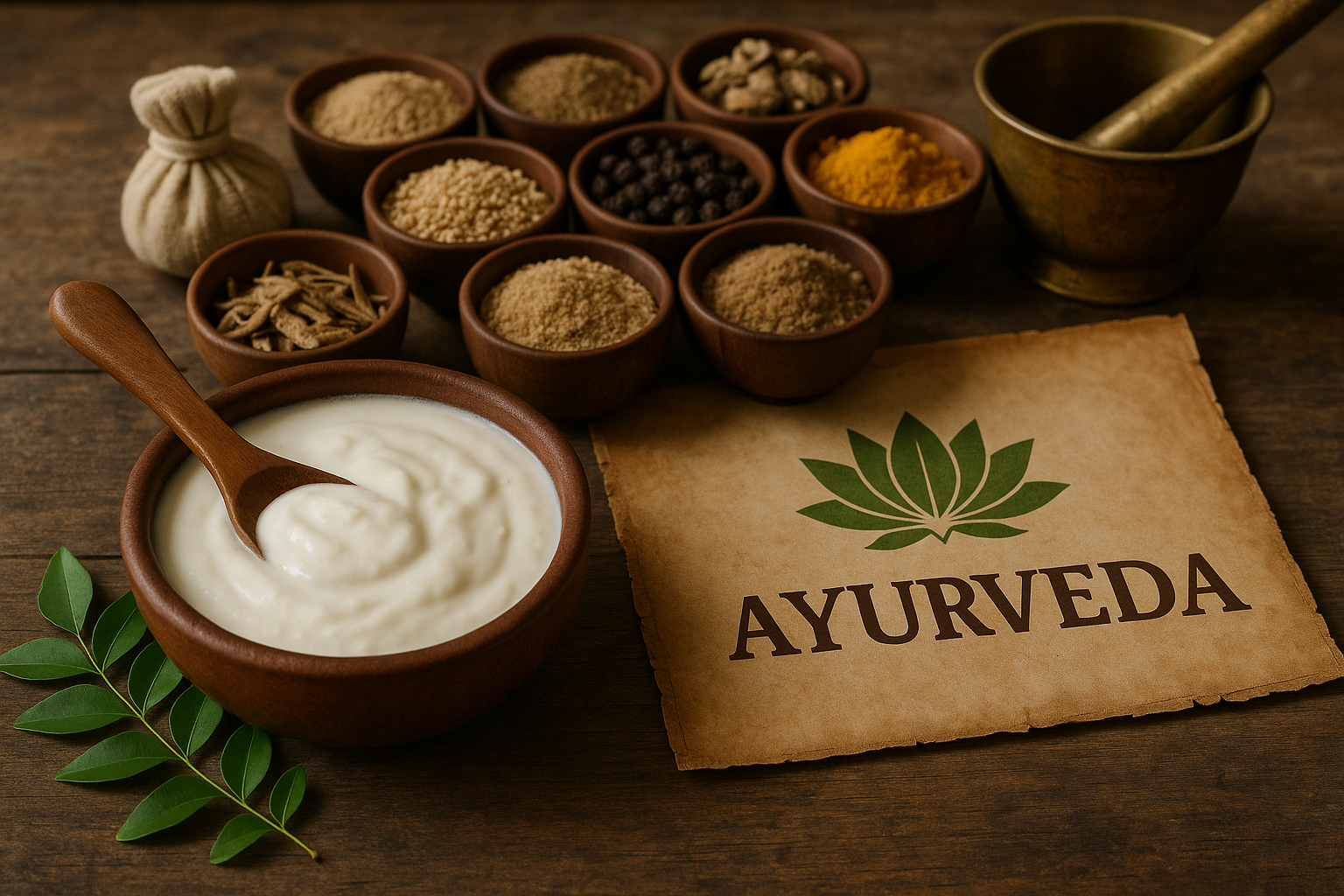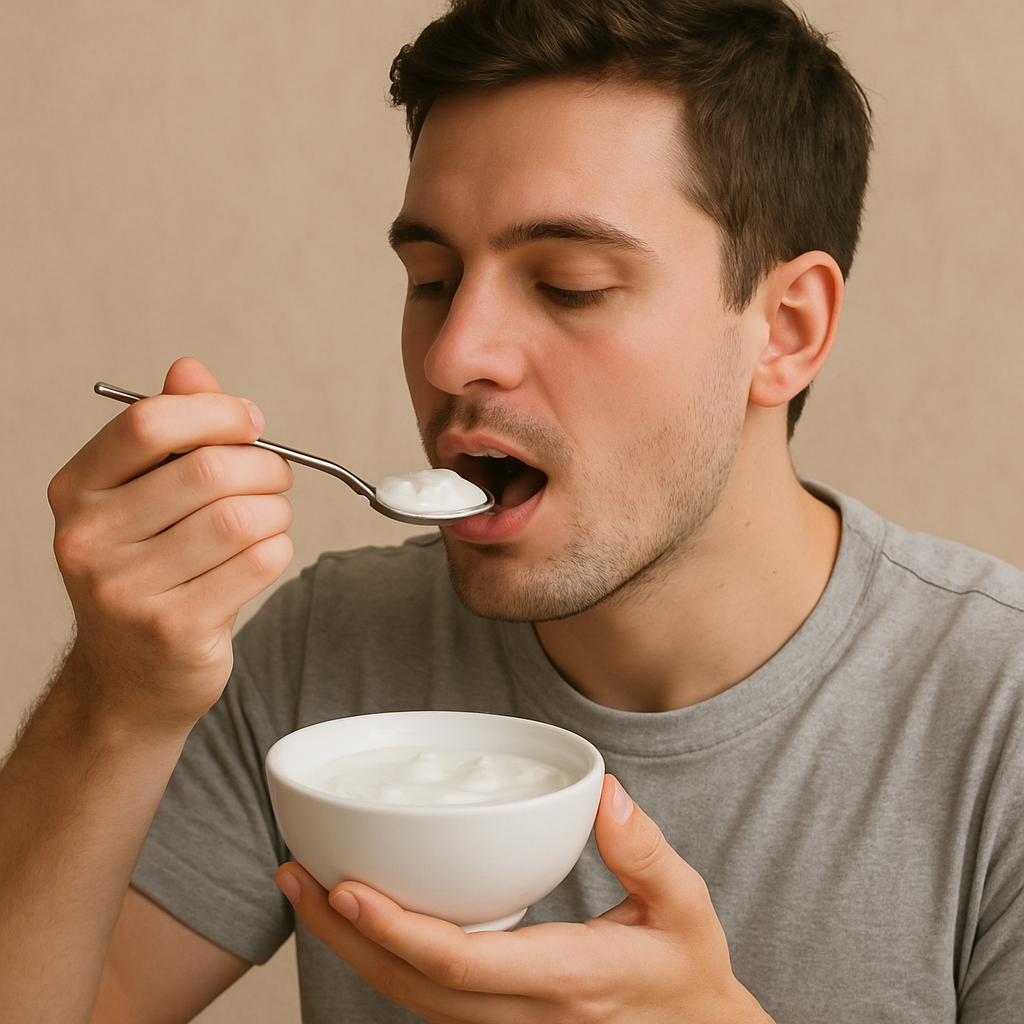Ask Ayurvedic doctor a question and get a consultation online on the problem of your concern in a free or paid mode. More than 2,000 experienced doctors work and wait for your questions on our site and help users to solve their health problems every day.
Shop Now in Our Store
Is Curd Heating or Cooling? Ayurvedic Truths, Diet Tips & Lifestyle Insights

Introduction: Is Curd Heating or Cooling in Ayurveda?
This might sound silly at first — “Is curd heating or cooling?” Like, really? We're debating yogurt now?
But if you’ve ever grown up in a household where grandma handed you a spoon of curd before exams, or your mom told you to skip it during a cold, you already know: this isn’t just yogurt. It’s practically medicine in Indian kitchens. And if you’ve stumbled into Ayurveda even a little, you’ll know that everything you eat — every spice, every grain, every sneaky bowl of curd — has energetic properties. So yes, we’re asking: is curd heating or cooling? And the answer... well, it’s not as straightforward as you’d like.
Ayurveda doesn’t believe in universal rules. It’s not a “good or bad” type of system. It’s all about balance, personal constitution (doshas), season, and even how you feel today versus yesterday.
Why does this matter? Because if you're battling digestion issues, skin flare-ups, or seasonal colds — and you keep spooning curd into your meals thinking it's healthy (because probiotics, right?) — you might actually be making things worse. On the flip side, done right, curd can be transformative.
This article dives deep — not in a textbooky, checklisty way — but in a real, lived, questioning kind of way. We’ll explore curd through the Ayurvedic lens, unravel dosha dynamics, break down practical diet tips, and even dig into lifestyle routines that’ll help you use (or avoid) curd in ways that feel right for your body.
If you’ve ever been confused by conflicting advice — or just want to finally know what Ayurveda really says about curd — you’re in the right place.
Let’s begin, spoon in hand.

Understanding the Role of Ayurveda in Managing “Is Curd Heating or Cooling?”
This isn’t just a food debate. It’s a whole Ayurvedic dilemma.
What Ayurveda Says About “Is Curd Heating or Cooling?”
In Ayurveda, foods are classified not just by nutrients or macros, but by their energy (virya), post-digestive effect (vipaka), and taste (rasa) — all of which influence your doshas (Vata, Pitta, Kapha).
Here’s the surprising bit: curd is considered heating (ushna virya). Yes, heating. Even though it feels cool on the tongue, even if it comes from the fridge, once inside your body, it aggravates Pitta and Kapha if taken incorrectly.
“But how? It's tangy, soft, and creamy!”
I know, it doesn’t feel fiery. But digestion isn’t about temperature — it’s about transformation.
Curd has a sour taste (amla rasa), and this sourness stimulates digestive fire (agni) — in moderation, that’s great. But in excess or in the wrong body type, it heats you up, causes acidity, inflammation, or even mucus accumulation.
And it’s heavy (guru) and sticky (picchila), which makes it harder to digest — especially for people with weak agni or kapha-predominant constitutions.
Ayurveda usually recommends curd only under certain conditions:
– During the day (never at night!)
– In moderate climates (avoid in peak summer or monsoon)
– With balancing spices like black pepper or cumin
– And ideally, not daily.
How Ayurvedic Lifestyle & Diet Directly Impact This Question
Let’s be real: most of us aren’t eating like ancient yogis. We're rushing, snacking, and refrigerating everything.
So even if curd could theoretically be good for digestion, the way we consume it — with sugar, with fruit, with dinner — flips its benefits.
Example:
– Having curd after spicy biryani at dinner? Acid reflux, coming up.
– Eating cold curd from the fridge in rainy season? Say hi to sinus congestion.
Ayurveda says: balance the qualities. If curd is heavy and heating, you need lightness and cooling in the rest of your meal or lifestyle to counter it. It’s a dance.
The Importance of Individualized Ayurvedic Approaches
You knew this was coming.
There is no one-size-fits-all answer.
For someone with dry skin, cold hands, and a scattered Vata mind, a little warm curd with ghee and spices might soothe.
But for a Pitta person — someone fiery, intense, already prone to acidity and rashes — curd might push them over the edge.
What’s your constitution? What season is it? Are you digesting well today? These questions matter more than whether curd is “good” or “bad.”
Ayurvedic Dietary Guidelines for “Is Curd Heating or Cooling?”
If you’re asking whether curd is heating or cooling, what you’re really asking is — should I eat this or not? And if yes, how?
Ayurveda gives nuanced answers. Not just “yes” or “no,” but “how, when, with what, and for whom?” So, let’s get into it.
Foods Recommended by Ayurveda for Balancing the Effects of Curd
Here’s the key: if you’re going to include curd, pair it wisely.
-
Spiced buttermilk (takra) is far more recommended than plain curd. It’s easier to digest, lighter, and can be adjusted for all doshas.
-
Warmed curd (not cold) with a sprinkle of roasted cumin, black pepper, and a pinch of rock salt makes it far more agreeable for digestion.
-
For Vata types, who tend toward dryness and irregular digestion, a little curd mixed with rice and ghee might be grounding — especially in winter.
-
Adding curd to kitchari with spices or using it in kadhi (a spiced yogurt-based curry) is also a good way to “cool the heat” of the heating nature.
It’s never about isolation — curd on its own is tricky. In a thoughtfully prepared dish, it can work with you.
Foods Ayurveda Suggests Avoiding With or After Curd
Brace yourself, because here’s where it gets strict:
-
No curd at night — ever. Ayurveda’s very firm on this. It disrupts digestion and leads to ama (toxins).
-
No curd with fruits — this combo is a digestion bomb. Mismatched digestion times lead to fermentation, bloating, and sluggishness.
-
Avoid mixing curd with meat, fish, or eggs — again, incompatible in energy and digestion.
-
Don’t take curd cold from the fridge — that kills agni (digestive fire). Always bring it to room temp, if not warm.
“But I love my yogurt parfait in the morning…”
Yeah, I get it. But Ayurveda's not about taste — it's about transformation. You can’t be glowing if your gut’s groaning.
Meal Planning and Timing Tips in Ayurveda for Curd
Timing really is everything.
-
Eat curd during the daytime, ideally with lunch, when agni is strongest.
-
Don’t consume it daily — think 2–3 times a week, max.
-
Combine with warming spices — like dry ginger powder, mustard seeds, curry leaves — to counter the heating nature.
-
If you feel sluggish after eating curd, that’s your body saying “Not right now, friend.”
Also, consider seasonal timing:
-
Best in late winter (Hemanta) when digestion is strong.
-
Avoid in monsoon (Varsha) — it increases Kapha and causes congestion.
Hydration and Beverage Recommendations (If Applicable)
Curd can make the body feel heavy or mucusy. So balance it with:
-
Warm water with lemon or cumin post-meal.
-
Herbal teas like tulsi, ginger, fennel.
-
And if you’re going to have a lassi, make it thin, spiced, and unsweetened. Think: digestion support, not dessert.
Ayurvedic Lifestyle Practices Specifically Beneficial for “Is Curd Heating or Cooling?”
Ayurveda is not just about what’s on your plate — it’s how you live.
Curd might be fine in your diet, but if your daily habits are off, your system will still rebel.
Daily Ayurvedic Routines (Dinacharya) to Balance Effects of Curd
Start your day right, and you’ll digest better all day — including curd.
-
Wake with the sun. Always.
-
Oil pulling and nasya (nasal oil application) clear out excess Kapha that curd can aggravate.
-
Dry brushing (garshana) in Kapha-prone people helps counter heaviness.
-
Tongue scraping shows you if ama is present — if it’s coated, skip curd today.
Morning movement — even a quick 15-minute walk or some sun salutations — activates digestion before you’ve even had breakfast.
Sleep Patterns and Ayurveda: Curd and Evening Routines
Nighttime curd? Still no.
-
Ayurveda says digestion winds down with the sun.
-
Curd at night leads to sluggishness, sinus issues, water retention, and more.
-
Have an early dinner — soup, steamed veggies, grains — and let curd rest till daylight.
If you notice weird dreams, a heavy head, or clogged skin, look back at your late-night snacks. Curd could be the culprit.
Ayurvedic Personal Care Practices
You’d be surprised, but Ayurveda even uses curd externally.
-
Curd mixed with turmeric and sandalwood = cooling face mask for inflamed skin.
-
Curd with gram flour = great for scalp and dandruff.
So while curd may heat your insides, it can cool your outsides — again, it’s all about how you use it.

Yoga & Breathing Techniques for Balancing Effects of Curd
Yes, curd is heating. But you don’t always have to avoid it — you can process it better if your system is strong. That’s where yoga and breath come in.
Yoga Asanas That Help with Curd Digestion
If you feel heavy or bloated after meals with curd, these poses are your best friends:
-
Pawanmuktasana (Wind-Relieving Pose)
-
Ardha Matsyendrasana (Half Spinal Twist)
-
Trikonasana (Triangle Pose)
-
Bhujangasana (Cobra Pose) to stimulate agni
-
Naukasana (Boat Pose) to tone abdominal muscles
Avoid overly heating sequences if you're Pitta-dominant or eating a lot of sour foods like curd.
Pranayama (Breathing) That Balances the Heating Quality
Pranayama can literally change your body temperature.
-
Sheetali and Sheetkari — classic cooling breaths.
-
Nadi Shodhana — balances right-left energy, calming for all doshas.
-
Bhramari — reduces mental heat and frustration (common with high Pitta).
Avoid Kapalabhati if you’re already feeling inflammation or heat from curd.
How Often to Practice?
Daily practice of:
-
15 mins of asanas,
-
10 mins of pranayama,
-
And short mindful rest…
…can help your body handle occasional indulgences like curd without backlash. Think of it as “earning your digestion.”
Stress Management & Emotional Health Tips for “Is Curd Heating or Cooling?”
Stress affects digestion — and that changes how your body processes food. Including curd.
Ever eaten something totally normal and still felt sick? Yep, that's stress messing with your agni.
Ayurvedic Techniques to Reduce Stress Related to Food Sensitivities
-
Abhyanga (self-oil massage) — especially with cooling oils like coconut or Brahmi.
-
Foot massage before bed — improves sleep, calms nervous system.
-
Sit quietly for 5 minutes after meals — no screens, no conversations. Just you and digestion.
Sounds simple, but try it. Your gut will thank you.
Meditation & Mindfulness Practices That Help
Ayurveda suggests Trataka (candle gazing) and Nada Yoga (sound meditation) to calm a fiery Pitta mind.
You can also journal about your meals — not for calories, but for how you feel after eating. If curd always leads to discomfort, no matter what people say, listen to your gut.
Literally.
Emotional & Psychological Factors Ayurveda Considers
Sometimes, food isn’t the enemy. It's our emotional state while eating it.
-
If you’re eating curd in a rush, full of guilt or uncertainty, digestion weakens.
-
If you eat with awareness, in calm surroundings, and with seasonal balance — even heating foods can be digested well.
Ayurveda reminds us that digestion isn’t just physical. It’s emotional, energetic, and mental too.
Practical Ayurvedic Home Remedies and Recipes for “Is Curd Heating or Cooling?”
Let’s get hands-on. Sometimes, curd is the villain. Other times, it’s the healer. Ayurveda loves a good paradox.
Simple and Effective Home Remedies Using Curd (The Right Way)
-
Curd + Black Pepper + Rock Salt
Mix 1 tbsp of warm (not hot) homemade curd with a pinch of black pepper and a touch of rock salt. Take this mid-day for light digestion. Works well for Vata types in winter. -
Curd Face Pack for Pitta Skin
Mix curd with a pinch of sandalwood powder and turmeric. Apply to inflamed, red, or acne-prone skin. Wash off with lukewarm water after 15 minutes. -
Takra for Digestion
Blend 1 part curd with 4 parts water. Add roasted cumin, grated ginger, and a pinch of hing (asafoetida). Sip post-lunch to soothe bloating and enhance digestion.
Old-school Ayurvedic doctors swear by takra. One even called it “nectar for the intestines.” Dramatic? Maybe. But it works.
Ayurvedic Recipe Ideas with Balanced Use of Curd
-
Kadhi with Curry Leaves & Mustard Seeds
A classic! Spiced, cooked, and diluted — kadhi makes curd digestible even for tricky doshas. Best consumed fresh, with warm rice and ghee. -
Beetroot Raita with Hing and Fennel
Beetroot is grounding, curd is cooling, and fennel balances the heat. A surprisingly perfect trio. -
Sweet Lassi (lightly spiced)
Not the dessert one. A pinch of cardamom, a drop of rose water, and just a touch of jaggery in a well-whisked buttermilk can cool Pitta without clogging digestion.
Preparation Tips for Ayurvedic Curd Use
-
Use fresh, homemade curd — always.
-
Never eat curd straight from the fridge.
-
Never reheat curd — warm it slightly with a hot water bath if needed.
-
Always add digestive spices.
-
Trust your gut — if it feels “off” after, back off.
Common Mistakes & Misconceptions About Ayurvedic Lifestyle and Curd
If I had a rupee for every time someone misunderstood curd in Ayurveda…
Myth 1: “Curd is cooling, because it feels cool.”
Nope. It’s heating in effect, cooling in feel. Don’t mix up sensation with post-digestive action. That’s like thinking sugar is relaxing because it makes you crash.
Myth 2: “Curd is probiotic, so it’s automatically healthy.”
Again, not always. Ayurveda isn’t interested in bacteria counts — it’s interested in what you can digest. If your agni is weak, even the best probiotic will turn to ama.
Mistake 1: Eating curd at night
Still no. Cold, heavy, and mucus-forming = disaster for nighttime digestion. Want something soothing? Try warm almond milk with nutmeg.
Mistake 2: Mixing curd with incompatible foods
Fruits, fish, meat, pickles, ice cream — all bad combos. Curd works best with warm grains, mild spices, or by itself.
How to Avoid These Mistakes
-
Listen to your body. Curd shouldn’t cause discomfort.
-
Don’t blindly follow health trends. Ayurveda isn’t anti-curd — it’s anti-indiscriminate use.
-
Know your dosha. What works for a Kapha won’t work for a Vata.
-
Consult a real Ayurvedic practitioner, not just Instagram quotes.

Real-Life Success Stories & Testimonials
You don’t need to believe Ayurveda. You can just try it.
Story 1: “I Gave Up Nighttime Curd & My Sinusitis Vanished”
Rohit, 35, from Delhi, used to eat curd every night with paratha. Chronic congestion, morning headaches — gone within 10 days of switching to lunch-only curd with cumin.
Story 2: “Buttermilk Saved My Gut After Antibiotics”
Neha, 28, from Pune, struggled with post-antibiotic bloating and constipation. Spiced buttermilk daily with lunch rebalanced her digestion in a week.
These aren’t miracles. They’re logic + consistency + a little old wisdom.
Scientific Evidence Supporting Ayurvedic Diet and Curd Practices
Yes, Ayurveda is old. But modern science is catching up.
Diet’s Impact on Curd Digestion
-
Fermented dairy improves gut flora — but only when digestion is intact.
-
Cold dairy has been linked to mucus production and slowed gastric emptying — aligning with Ayurvedic warnings.
Clinical Research on Ayurvedic Fermentation
Studies have validated the health benefits of takra (buttermilk) — showing improved digestion, better lactose tolerance, and gut lining support.
Also:
-
Spices like cumin and ginger increase bile flow, making curd easier to digest.
-
Cooking curd (like in kadhi) denatures proteins in ways that help prevent allergic reactions.
Expert Opinions
Dr. Vasant Lad (renowned Ayurvedic physician):
“Curd is not bad. Misused curd is bad. Food is only medicine when taken correctly.”
Modern integrative nutritionists now echo the same: personalization is key.
Conclusion: What Ayurveda Really Teaches About Curd
So... is curd heating or cooling?
Technically heating — but not in a scary, villainous way. Just in a “don’t abuse it” kind of way.
Ayurveda doesn’t say “stop eating curd.” It says:
-
Know your dosha.
-
Know your digestion.
-
Know your season.
-
Know your timing.
-
And above all, know yourself.
If you follow the rhythms of nature and your own body, curd can absolutely have a place in your diet.
But if you’re using it mindlessly, daily, with incompatible foods or wrong timings — yes, it can backfire.
Takeaway?
Respect curd. Use it well. And when in doubt — choose takra.
Ready to personalize your Ayurvedic diet?
Book a consultation with an experienced Ayurvedic expert who can guide your unique path — food, lifestyle, and all. You don’t have to guess anymore.
FAQs About Curd in Ayurveda
Q1: Can I eat curd at night?
No. Ayurveda strongly discourages it. Curd at night can lead to mucus buildup, poor digestion, and disturbed sleep.
Q2: What’s the best way to consume curd?
Mid-day, in moderate amounts, spiced with cumin or black pepper. Preferably homemade and slightly warmed.
Q3: Is buttermilk better than curd?
Yes. Buttermilk (takra) is lighter, easier to digest, and can be adapted for all doshas with the right spices.
Q4: Can Kapha types eat curd?
Very sparingly. Only when agni is strong and never in the cold/rainy season. Better to go for diluted buttermilk with warming spices.
Q5: Is curd suitable in summer?
Not ideally. Curd’s heating nature can aggravate Pitta in hot weather. Opt for thin, unsweetened lassi with cooling herbs like mint or coriander.
References & Credible Sources
-
National Ayurvedic Medical Association (NAMA) -
Ministry of AYUSH, Government of India -
National Center for Complementary and Integrative Health (NCCIH) -
University of Maryland Medical Center – Integrative Medicine
-
All India Institute of Ayurveda (AIIA)
This article is checked by the current qualified Dr Sujal Patil and can be considered a reliable source of information for users of the site.

